
Tanzania Trip -- Monday, July 16, 2012
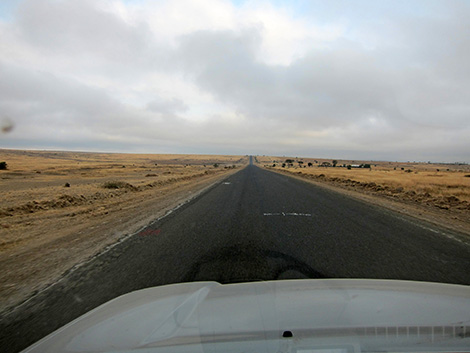 Open grasslands of the Masai Steppe |
Day 10. Monday, July 16. Arusha, TZ, to Babati, TZ. Day 3 in Tanzania. We got up and out early (departed hotel at 0700 hrs) traveling by Toyota Land Cruiser from Arusha to Babati. The trip was amazing and took the expected 2-1/2 hrs, even after Cathy asked Tano to drive more slowly. We checked into the White Rose Hotel on the south end of town near Lake Babati, then went to the Regional Commissioner's office to register Cathy's Tanzanian research permit. That took longer than we had expected, but with the proper papers, Cathy is set to begin her interviews. I tagged along until after lunch, then returned to the hotel. Lots of new birds today. Link to trip map. |
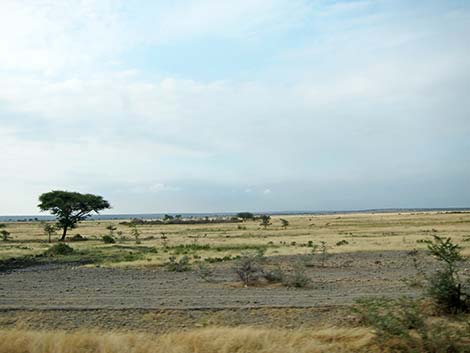 Masai Steppe and Masai boma in distance |
Today we planned to go to bed early and get up early, hoping to be on the highway before 0700 hrs. Events have a way of throwing aside even the best laid plans, and my jet-lagged body gave in. I stayed up too late dealing with photos and email, so I didn't get to bed until after midnight, and this morning I was awoken by the sound of an alarm just before 0300 hrs. It could have been a fire alarm, perhaps a burglar alarm, or just a car alarm, but of fear for a fire alarm, I couldn't sleep through it. When it was finally turned off, I was wide awake listening to the sounds of the city with motorcycles whizzing down the road, old trucks needing mufflers, and lots and lots of dogs. |
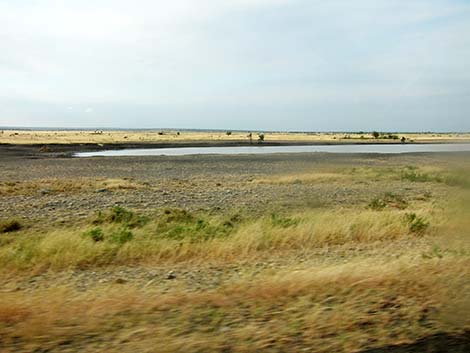 Catch basin for rainfall runoff on the Masai Steppe |
It took a long time to fall back to sleep, but eventually I did, only be awoken by the sounds of chanting on a loud speaker. Could it be the Muslim call to payer at dawn? No, it was too early for that. I listened carefully to the chanting -- it was "hallelujah, hallelujah, hallelujah, ..." interspersed with words in Swahili. It seems the Christians were making a call to prayer before the Muslims. Well, that was hard to sleep through, but eventually it stopped. But wait, there's more! Soon it was the Muslims having their time at the loud speakers. It was 0445, I was wide awake and not going back to sleep, so I got up. |
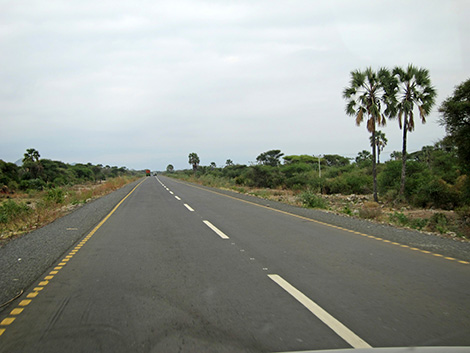 Near Lake Manyara, more soil moisture and plants |
Now, at a few minutes before 0600, the appointed get-up time, I'm up, dressed, packed and ready to go look for some coffee. The chanting has stopped, but the dogs and other city noises continue. To think, I would have missed all of this if I'd only stayed asleep. I guess there will be time to sleep when I get home. After a light breakfast and in the overcast early light of dawn, we hit the road with Tano driving. The morning traffic in Arusha was astounding: people walking everywhere, cars and trucks seemingly driving at random, school buses passing in city traffic, and hoards of people walking and riding bikes on the shoulder. I'm glad I didn't have to drive! |
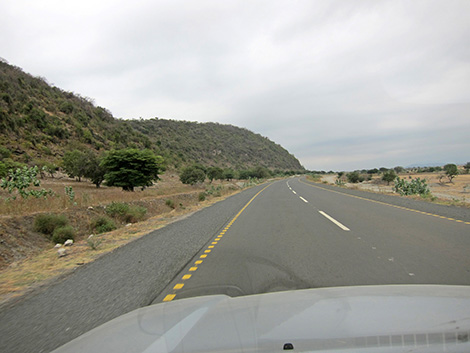 Hills along highway |
After we got out of town, the highway opened up as we headed west, then south across the Masai Steppe. The landscape was gently rolling plains with scattered low trees and shrubs. This is the ancestral homeland of the Masai, and the generations of overgrazing were evident in the eroded landscape. It was interesting to see the family "bomas" along the road. We saw traditional clusters of round huts made of mud and thatch surrounded by fencing. Lydia explained that each boma was a polygamous family unit comprised of one man, few to many wives, and all of their children. Life revolves around cattle and goat herding, and the animals are grazed during the day and herded into the boma at night. Cattle and goats are welcome to sleep inside the huts with people. |
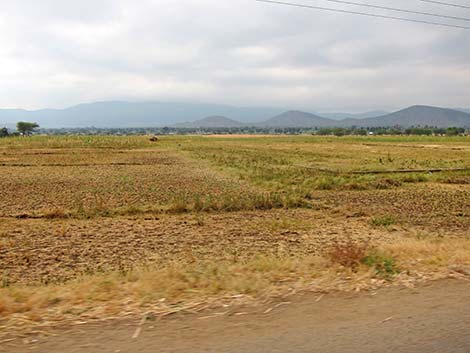 Rice fields (dry during the summer season) |
Beyond the Masai Steppe, the landscape became more hilly and more moist. Trees became taller and more dense, palm trees began to appear, and we could see Lake Manyara and the Rift Valley Escarpment in the distance. Baobab tree also became common. Birds were common along the drive. Highlights of the dryer parts of the drive included Fork-tailed Drongo, Red-billed Buffalo Weaver, African Paradise Flycatcher (darn, only females with short tails), a Secretary Bird that flew across the road, and unidentified sandgrouse. In the wetter areas, avian highlights included Black-headed Heron and Goliath Heron. |
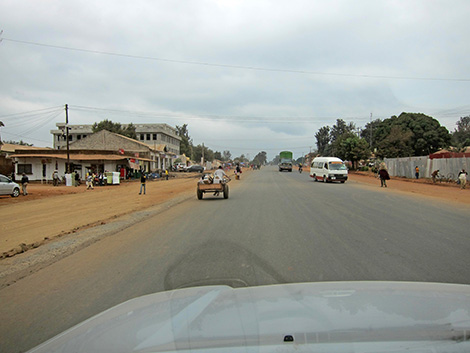 Main north-south highway through Babati town |
We arrived in Babati about 0930, and quickly set off to meet the regional officials. While Cathy and Lydia went inside, Tano and I stayed outside. Everything took longer than expected, but that gave me a chance to wander about the grounds and look for birds. Highlights there included Speckled Pigeon, an African Pied Wagtail feeding its fledgling, Baglafecht Weavers working on their nests, a pair of Common Fiscal, and even a Lanner Falcon. We all went to lunch, a chopped up, grilled chicken, and then I went back to the hotel to nap while Cathy and Lydia went to work. Long after sunset, they woke me to come out for a late dinner. I guess the early morning get-up caught up to me. We have no Internet at the hotel, so hopefully I can find an Internet cafe tomorrow and upload the new photos and information. |
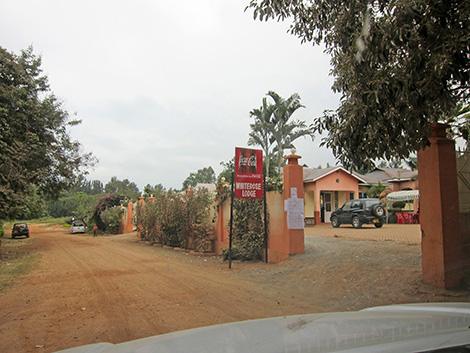 Road entrance to White Rose Hotel |
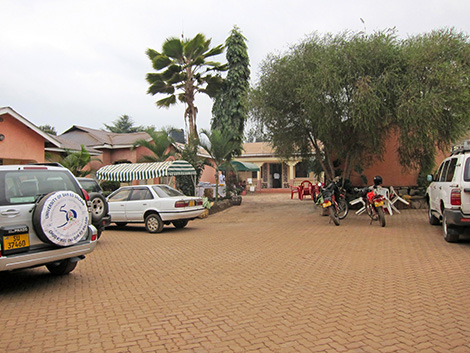 Parking and courtyard at White Rose Hotel |
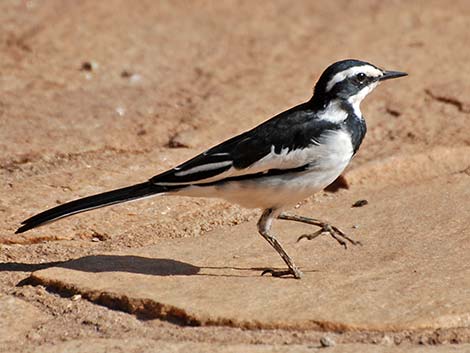 African Pied Wagtail (Motacilla aguimp) in hotel courtyard |
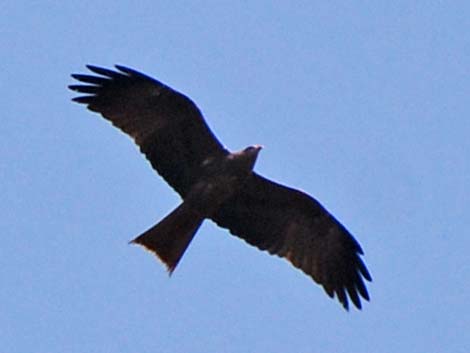 One of two Black Kites (Milvus migrans) flying above the hotel |
Note: All distances, elevations, and other facts are approximate.
![]() ; Last updated 240224
; Last updated 240224
| Tanzania Trip | Postcards | Copyright, Conditions, Disclaimer | Home |